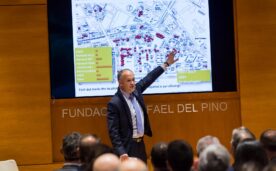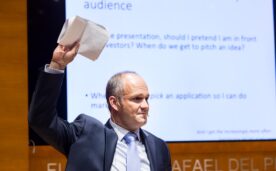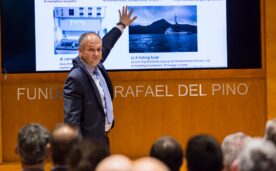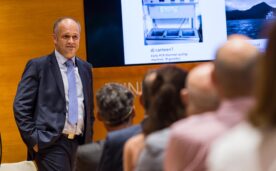Innovation and investment in artificial intelligence
Summary:
On 24 May 2018, the Rafael del Pino Foundation hosted a keynote speech by Luis Pérez-Breva, director of the MIT Innovation Team, on "Innovation and investment in artificial intelligence", on the occasion of the presentation of the Spanish edition of his book "Innovar: un manifiesto de acción" (Innovate: a manifesto of action). Pérez-Breva said that when it comes to innovation, we like to think that we start with a disruptive idea. The reality, however, is very different. You don't start this way because no one can know, a priori, whether an idea is disruptive. In reality, the beginning of it all is a crazy idea, an absurd combination. What comes next is a fixation on solving all the problems that arise when developing this outlandish idea, because they are problems that, until now, have not been solved by anyone. In this sense, Pérez-Breva gave as an example the experience of Space X, Elon Musk's space company. Musk wanted to send a small greenhouse to Mars to start preparing the Red Planet for colonisation and, faced with the difficulties in carrying out his idea, he ended up creating Space-X, which today provides transport to the space station. To move forward, the first step is to prove to oneself, with the facts and with the resources at one's disposal, what makes the initial idea seem far-fetched. This is the case with the electric car, which consists of attaching a battery to the vehicle. This principle is more feasible than it seems. After that, it is all a question of solving problems until you have a prototype, something that can be scaled up. Innovation and entrepreneurship are two different things. Sometimes you do both at the same time, sometimes you don't need to create a new company, sometimes you create a new organisation with new ideas. Innovation requires a different mindset. Failure is not an option, nor is there a minimally viable product to start with. What there are are people, parts and an elusive problem that promises to one day explain how parts and people fit together. Everything else - technology, business models, art, product, ...) comes along the way. And the end is yet to be discovered, while along the way you become an expert. In this sense, Pérez-Breva argues that predicting the future is difficult; building it is not. That leads to the problem of product myopia, that is, we recognise innovations after they succeed as products, but it is hard to go beyond that to see the organisation and its origins. Then we try to predict products and fail to realise the visions. Innovation is about solving problems with the pieces that are available. On this point, Pérez-Breva gave the example of the birth of Greenpeace. It was a group of people concerned about the environment who wanted to stop a US nuclear test. The pieces to combine were an advertisement, a concert, a fishing boat, the opinion pages and various social groups. What they did was to announce their purpose, organise a concert to raise funds, and charter a fishing boat to try to stop the bomb from being detonated. As the boat made its way along its route, it broadcast everything that was happening on the radio. The boat failed to prevent the explosion, but the media picked up on its voyage, and the whole story, and published stories about it, which awakened the consciences of many people. The organisers then decided to found Greenpeace. An analogy can be drawn between innovation and the three laws of prediction enunciated by the British scientist Arthur C. Clarke. According to these laws, when an eminent but elderly scientist claims that something is possible, he is most certainly right; when he claims that something is impossible, he is most likely wrong. Moreover, the only way to discover the limits of the possible is to venture a little further into the realm of the impossible. Finally, any sufficiently advanced technology is indistinguishable from magic. Well, what the innovator does is push the boundaries of the possible, but it is the advanced technology that fascinates others. The innovator's task, therefore, is to venture a little into the realm of the impossible. His tools are parts, people and problems. The result is innovation. The next question is: is it possible to invest directly in innovation? Today the options are to invest in start-ups. However, start-ups increasingly represent a smaller percentage of the economy. There are more start-ups than ever before, but they grow less and die sooner. Meanwhile, in the United States, large companies are providing more jobs than small companies for the first time since 2003. Despite this, we are committed to start-ups because entrepreneurs who innovate are the cause of economic progress. Investment in innovation has to align the interests of long-term investors and foundations or benefactors. Open the door for them to actively invest in making the economy sustainable with technology as a tool for innovation. There must also be investment and working tools competitive with venture capital that attract talent with a desire to innovate. In this sense, it must be borne in mind that there is talent that wants to innovate, but has no interest in entrepreneurship. Finally, it should be borne in mind that there are investors who are looking for long-term impact. As far as artificial intelligence is concerned, Pérez-Breva explained that it is an aspiration to achieve another type of intelligence, a field of research that straddles many others, and a cause for panic due to a tiresome misunderstanding. What is being heralded as artificial intelligence are technologies such as pattern recognition, machine learning, statistical and data analysis tools, natural language processing, robotics and automation, which already existed, and anything else that can be done with a computer. At the same time, the products that are imagined are segmentation for online marketing, prediction of future values, recommendation systems, chess and go, chatbots and voice systems, robots and autonomous vehicles, all kinds of data, and so on. The evidence, however, points to the fact that all these are neither great ideas nor artificial intelligence. It is imagination that fails, because of the mental models we have limited ourselves to, according to which artificial intelligence serves to reduce human resources, is restricted to performing tasks that humans do best, assumes that data is valuable and that we need complex patterns to predict rules for the behaviour of complex systems. What we need to do is to envision opportunities, such as bringing together pieces of information from different sources without a preconceived model, finding information using examples, constructing narratives that explain complex data, and tackling real problems that we cannot solve in any other way. Artificial intelligence can make science more accessible to use.
The Rafael del Pino Foundation is not responsible for the comments, opinions or statements made by the people who participate in its activities and which are expressed as a result of their inalienable right to freedom of expression and under their sole responsibility. The contents included in the summary of this conference are the result of the debates held at the meeting held for this purpose at the Foundation and are the responsibility of their authors.
The Rafael del Pino Foundation is not responsible for any comments, opinions or statements made by third parties. In this respect, the FRP is not obliged to monitor the views expressed by such third parties who participate in its activities and which are expressed as a result of their inalienable right to freedom of expression and under their own responsibility. The contents included in the summary of this conference are the result of the discussions that took place during the conference organised for this purpose at the Foundation and are the sole responsibility of its authors.







